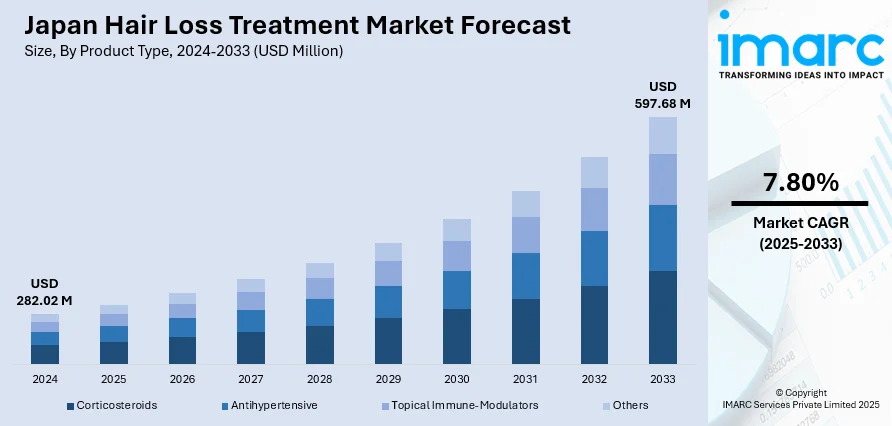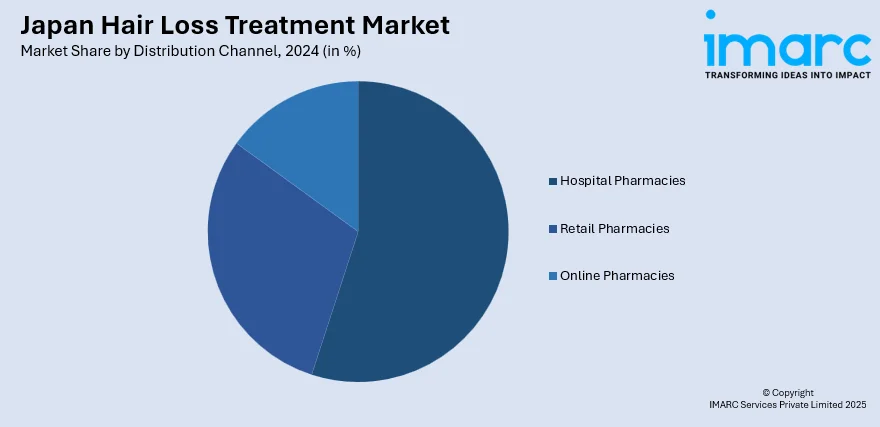
Japan Hair Loss Treatment Market Size, Share, Trends and Forecast by Product Type, Type, Route of Administration, Gender, Distribution Channel, and Region, 2025-2033
Japan Hair Loss Treatment Market Overview:
The Japan hair loss treatment market size reached USD 282.02 Million in 2024. Looking forward, IMARC Group expects the market to reach USD 597.68 Million by 2033, exhibiting a growth rate (CAGR) of 7.80% during 2025-2033. The market is driven by increasing hair loss among men and women, caused by aging or an altered lifestyle. Moreover, growing awareness about treatment options, both medication and noninvasive procedures, fuels the market expansion. In addition, advancements in technology, research and development (R&D) activities, and the demand for cosmetic procedures are some of the major factors augmenting the Japan hair loss treatment market share.
|
Report Attribute
|
Key Statistics
|
|---|---|
|
Base Year
|
2024
|
|
Forecast Years
|
2025-2033
|
|
Historical Years
|
2019-2024
|
| Market Size in 2024 | USD 282.02 Million |
| Market Forecast in 2033 | USD 597.68 Million |
| Market Growth Rate 2025-2033 | 7.80% |
Japan Hair Loss Treatment Market Trends:
Increasing Prevalence of Hair Loss
The growing prevalence of hair loss in Japan is one of the key drivers of market growth. As per an industry report, Japan has the highest incidences of alopecia, about 26%, with 7.8% of females experiencing some hair thinning. Besides this, as the population grows older, hair thinning and baldness become a more prevalent condition. This trend exists among the younger population, as well as stress, poor diet, and environmental pollution. Additionally, an increase in lifestyle diseases, such as diabetes and high blood pressure, also hastens hair loss, contributing to the market expansion. Also, hereditary causes contribute heavily, with a large percentage of people suffering from male and female pattern baldness. This growing incidence is creating an increasing demand for efficient solutions, which in turn has created new products and services in the market. Other than this, customers are increasingly turning towards professional treatments, supplements, and over-the-counter remedies, which is providing an impetus to Japan hair loss treatment market growth. With increasing awareness of the causes of baldness, treatments are becoming increasingly popular to overcome this common affliction.

To get more information on this market, Request Sample
Technological Advancements in Hair Loss Treatments
The market is experiencing an upsurge in technological developments, especially in non-invasive treatments and devices meant for domestic use. Laser therapy, for example, is becoming popular as a non-surgical, FDA-approved treatment for triggering hair growth. Moreover, laser machines are more affordable and reachable, and consumers can incorporate treatment into their daily regimen. Further, breakthroughs in hair transplant technology, such as robotic transplant technology and FUE (Follicular Unit Extraction) procedures, have maximized the accuracy and results of hair restoration treatments. Notably, Shiseido, a prominent multinational cosmetics company in Japan, has led the way in a revolutionary breakthrough in hair regeneration through its S-DSC® therapy. The firm began providing this treatment to patients in Japan on July 1, 2024. The treatment is done by growing a patient's DSCs (dermal stem cells) and injecting them into the scalp to induce hair growth. This new procedure is a landmark in hair restoration technology. These developments shorten recovery time, enhance outcomes, and limit scarring, making them more attractive to patients. In addition, genetic studies are assisting in making treatments more specific to patient's genetic makeup, enhancing their efficacy. The combination of these technologies expands the range of choices and enhances the performance of treatments, once again fueling consumer interest in superior and more advanced solutions. This shift represents the expanding function of technology in redefining the hair loss treatment landscape.
Japan Hair Loss Treatment Market Segmentation:
IMARC Group provides an analysis of the key trends in each segment of the market, along with forecasts at the country and regional levels for 2025-2033. Our report has categorized the market based on product type, type, route of administration, gender, and distribution channel.
Product Type Insights:
- Corticosteroids
- Antihypertensive
- Topical Immune-Modulators
- Others
The report has provided a detailed breakup and analysis of the market based on the product type. This includes corticosteroids, antihypertensive, topical immune-modulators, and others.
Type Insights:
- Non Cicatricial
- Telogen Effluvium
- Androgenetic Alopecia
- Alopecia Areata
- Cicatricial
- Others
A detailed breakup and analysis of the market based on the type have also been provided in the report. This includes non cicatricial (telogen effluvium, androgenetic alopecia, and alopecia areata), cicatricial, and others.
Route of Administration Insights:
- Oral
- Topical
The report has provided a detailed breakup and analysis of the market based on the route of administration. This includes oral and topical.
Gender Insights:
- Male
- Female
A detailed breakup and analysis of the market based on the gender have also been provided in the report. This includes male and female.
Distribution Channel Insights:

- Hospital Pharmacies
- Retail Pharmacies
- Online Pharmacies
A detailed breakup and analysis of the market based on the distribution channel have also been provided in the report. This includes hospital pharmacies, retail pharmacies, and online pharmacies.
Regional Insights:
- Kanto Region
- Kansai/Kinki Region
- Central/ Chubu Region
- Kyushu-Okinawa Region
- Tohoku Region
- Chugoku Region
- Hokkaido Region
- Shikoku Region
The report has also provided a comprehensive analysis of all the major regional markets, which include Kanto Region, Kansai/Kinki Region, Central/ Chubu Region, Kyushu-Okinawa Region, Tohoku Region, Chugoku Region, Hokkaido Region, and Shikoku Region.
Competitive Landscape:
The market research report has also provided a comprehensive analysis of the competitive landscape. Competitive analysis such as market structure, key player positioning, top winning strategies, competitive dashboard, and company evaluation quadrant has been covered in the report. Also, detailed profiles of all major companies have been provided.
Japan Hair Loss Treatment Market News:
- On March 9, 2024, Japan's Aderans Co., a leader in hair restoration, announced a strategic licensing contract with U.S.-based Stemson Therapeutics. This partnership grants Stemson exclusive global rights to develop and commercialize Aderans' proprietary hair regeneration cell therapy technology. The collaboration aims to accelerate the development of advanced stem cell-based treatments for hair loss, leveraging Stemson's expertise in induced pluripotent stem cell (iPSC) technology.
Japan Hair Loss Treatment Market Report Coverage:
| Report Features | Details |
|---|---|
| Base Year of the Analysis | 2024 |
| Historical Period | 2019-2024 |
| Forecast Period | 2025-2033 |
| Units | Million USD |
| Scope of the Report |
Exploration of Historical Trends and Market Outlook, Industry Catalysts and Challenges, Segment-Wise Historical and Future Market Assessment:
|
| Product Types Covered | Corticosteroids, Antihypertensive, Topical Immune-Modulators, Others |
| Types Covered |
|
| Route of Administrations Covered | Oral, Topical |
| Genders Covered | Male, Female |
| Distribution Channels Covered | Hospital Pharmacies, Retail Pharmacies, Online Pharmacies |
| Regions Covered | Kanto Region, Kansai/Kinki Region, Central/ Chubu Region, Kyushu-Okinawa Region, Tohoku Region, Chugoku Region, Hokkaido Region, Shikoku Region |
| Customization Scope | 10% Free Customization |
| Post-Sale Analyst Support | 10-12 Weeks |
| Delivery Format | PDF and Excel through Email (We can also provide the editable version of the report in PPT/Word format on special request) |
Key Questions Answered in This Report:
- How has the Japan hair loss treatment market performed so far and how will it perform in the coming years?
- What is the breakup of the Japan hair loss treatment market on the basis of product type?
- What is the breakup of the Japan hair loss treatment market on the basis of type?
- What is the breakup of the Japan hair loss treatment market on the basis of route of administration?
- What is the breakup of the Japan hair loss treatment market on the basis of gender?
- What is the breakup of the Japan hair loss treatment market on the basis of distribution channel?
- What is the breakup of the Japan hair loss treatment market on the basis of region?
- What are the various stages in the value chain of the Japan hair loss treatment market?
- What are the key driving factors and challenges in the Japan hair loss treatment market?
- What is the structure of the Japan hair loss treatment market and who are the key players?
- What is the degree of competition in the Japan hair loss treatment market?
Key Benefits for Stakeholders:
- IMARC’s industry report offers a comprehensive quantitative analysis of various market segments, historical and current market trends, market forecasts, and dynamics of the Japan hair loss treatment market from 2019-2033.
- The research report provides the latest information on the market drivers, challenges, and opportunities in the Japan hair loss treatment market.
- Porter's five forces analysis assist stakeholders in assessing the impact of new entrants, competitive rivalry, supplier power, buyer power, and the threat of substitution. It helps stakeholders to analyze the level of competition within the Japan hair loss treatment industry and its attractiveness.
- Competitive landscape allows stakeholders to understand their competitive environment and provides an insight into the current positions of key players in the market.
Need more help?
- Speak to our experienced analysts for insights on the current market scenarios.
- Include additional segments and countries to customize the report as per your requirement.
- Gain an unparalleled competitive advantage in your domain by understanding how to utilize the report and positively impacting your operations and revenue.
- For further assistance, please connect with our analysts.
 Request Customization
Request Customization
 Speak to an Analyst
Speak to an Analyst
 Request Brochure
Request Brochure
 Inquire Before Buying
Inquire Before Buying




.webp)




.webp)












